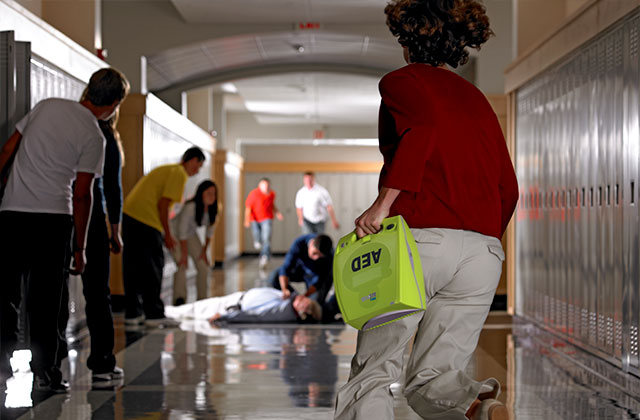Help save a life
Use an Automated External Defibrillator (AED) to help someone in sudden cardiac arrest.

An AED, or automated external defibrillator, is a small device that sends an electric pulse or shock to someone’s heart. An AED can restart a heart that has suddenly stopped beating. It can also correct a heartbeat that’s uneven, too fast, or too slow.
An AED is like the reset switch on your house’s circuit breaker. It’s the reset switch for your heart.
They're designed for people who have no training or medical background. Just turn on the device and follow the voice instructions. It will talk to you!
For example, the AED will tell you:
- To shake the patient and shout, "Are you okay?"
- Where to place the pads on the patient's chest.
- When to push the button that sends a shock to the patient's heart.
- When to "stand clear".
- How to do chest compressions.
An AED is simple and safe to use. It will never deliver a shock to someone who doesn't need it. There's a low risk of harming the patient or yourself, even if you use it incorrectly.
If the patient is injured or dies while you're acting to save their life, you cannot be held liable. In Ontario, anyone who performs CPR or uses an AED to help someone in need is protected by the Good Samaritan Act.
In Peel, teenagers, office workers, coaches, and family members have used an AED to try to save a life. You can too.
Book an AED demonstration
Peel paramedics staff give AED demonstrations throughout the year. If your group is interested in an AED demonstration, email us. We cannot guarantee someone will be available as we rely on staff volunteers.
Other information
Peel paramedics have one of the highest cardiac save rates in North America. Despite this, more than 1,300 people die from the condition in Peel each year.
When someone collapses from sudden cardiac arrest, time is critical. If they do not receive help before paramedics arrive:
- Brain damage will likely start after 6 minutes.
- There is a less than 2% chance they will survive beyond 10 minutes.
However, if someone uses an AED on a patient within 3 minutes of collapse, their chance of survival increases. You can even reverse brain damage.
An AED gives you the chance to help someone in need. If you see someone in cardiac arrest, be the one. Act to save a life. We say act to save a life to emphasize the importance of the action, not the outcome. The goal is for you to help.
There are hundreds of AEDs in Peel for anyone to use. Look for them in:
- Schools
- Libraries
- Community centres
- Swimming pools, gyms, and sports arenas
- Shopping malls
- Any Regional- or city-owned building open to the public
In buildings, you can usually find an AED near the security office or elevators. In schools, they're typically in the lobby or near the principal's office.
Use an AED when someone is experiencing sudden cardiac arrest. This means they are:
- Unconscious
- Not breathing (or not breathing properly)
Someone is unconscious when they don't respond to loud noises, pinching, or shaking. They have likely fainted, and they don't appear to be breathing.
How to use an AED
- Call 911.
- Open the AED if it's in a case.
- Turn it on. It will speak to you and tell you what to do.
- Follow the instructions.
- Do chest compressions as instructed by the AED.
The chain of survival highlighted what to do in a cardiac emergency. Your goal is to reduce the time between someone collapsing and receiving advanced care.
Early access
Call 911 right away. You want paramedics to arrive as soon as possible.
Early CPR
When you start CPR right away, you "buy time" until an AED arrives.
Early AED
When you use an AED within the first 3 minutes of collapse, the patient's odds of surviving increases by 80%.
Early advanced care
Paramedics can begin advanced care before the patient reaches the hospital.





